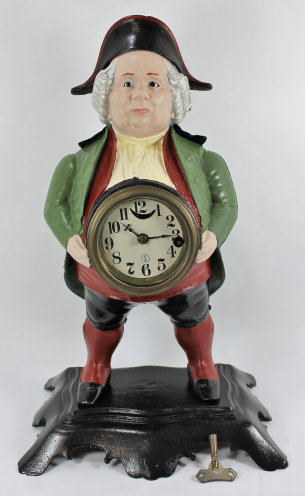

400. $125
German RA with an 8 day time only unsigned movement. The
unusual case is 31 inches tall without two missing finials on the top. The front of the case has unusual carvings and decorations
on each side of the door and on top. The long pendulum is original and the “RA” porcelain part of the pendulum is excellent. Also
the porcelain dial is perfect and it has original hands. The movement is held to a metal backboard bracket with thumb screws. The
clock is running. Over all a very nice clock that you won’t have to stop when company spends the night. $200-$350.
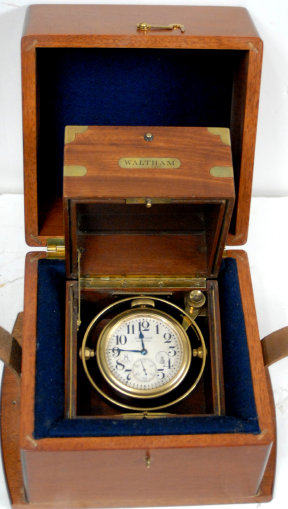
401. $450
Waltham Chronometer mounted on gimbals. Wooden inner box with
an outer carrying case that is belt strapped. The first mounted chronometers purchased by the Naval Observatory were made by the Waltham
Watch Co. They were an 8 day, 15 jewel, 37 size movement mounted in a wooden box. They were made over a 29 year period and approximately
16,000 were made as box chronometers. The movement was originally an automobile clock. Roth Bros. of New York upgraded some of the
automobile clocks from 7 jewel to 15 jewel and mounted them in a box to meet Naval specifications at that time before Hamilton got
into the chronometer business. This unit is in near perfect condition and is running. Inner box is numbered, “1778”. $500-$750.
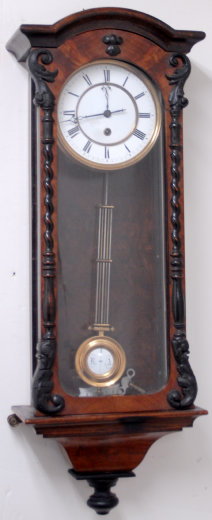
402. $450
Waltham Watch Company, Waltham, Mass. 8 day Lever Escapement
Chronometer. Same as #401 except it was probably sold to a jewelry store as a window display showing the public the many attributes
of the fine workmanship. It has 15 fine diamond, ruby and sapphire jewels in settings. It has a patent Breguet hairspring, winding
indicator. The movement is enclosed in a dust and weather proof case with screw back and bezel and fitted in a substantial, polished
mahogany box with brass trimmings. It is running. $500-$750.
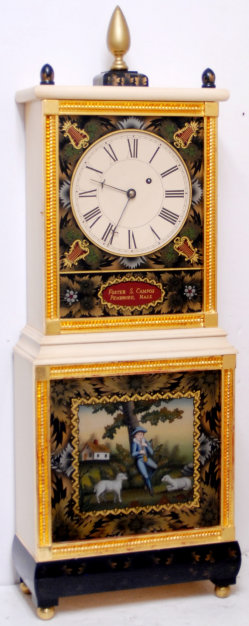
403. $1500
Foster Campos, Pembroke, Mass. Mr. Campos was a well known and
respected maker of of early American shelf clocks. His reproductions were some of the finest Mass. shelf clocks made since the early
1800’s. This clock is sometimes called a Brides clock, no doubt because of the off white painted wood case with gold decorations around
the signed Tom Moberg painted glasses. The top finial and the four round feet are also painted gold. The wood case is 35 inches high
and 13 inches wide. The 8 day movement and the case are signed. Painted on the upper glass is, “Foster S. Campos / Pembroke, Mass.”.
The painted dial is dished and has hand made hands. The original pendulum, weight, and crank are included. The 8 day weight driven
movement with passing strike on the hour is in fine running condition. The clock is in outstanding original condition. These reproduction
Aaron Willard type shelf clocks regularly sell at the east coast live auctions from $3000 to $4000. Even the cheaper versions sell
up to $2000. Probably not that much down here in mid America.
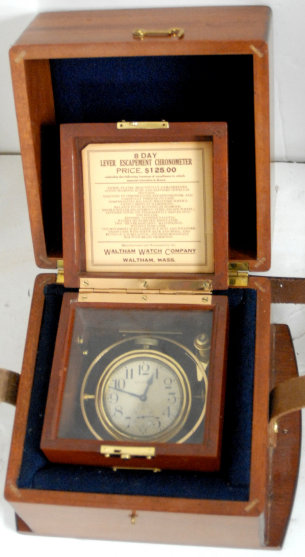
500. $50
Ansonia “Tourist” nickel-plated carriage clock, ca. 1914. This is a large carriage, 6 inches
high with the handle down. It’s only a one-day but has a strike and an alarm. It is running and keeping time but not striking. The alarm is working. The finish is not good, with considerable corrosion that will take some work to clear. The movement
and dial are signed. $50-$100.
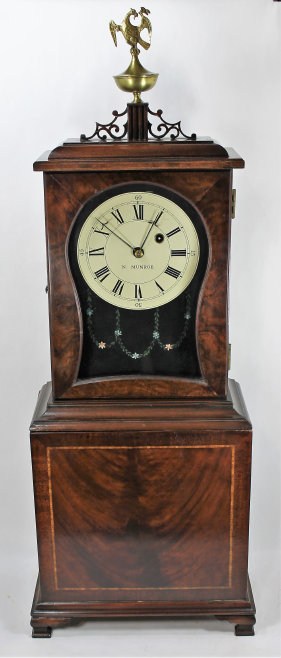
501. $3500
N. Munroe “Massachusetts Shelf Clock”, ca. 1810. Nathaniel Munroe was the middle brother
to Daniel and William, all of whom started out in Concord MA. Daniel apprenticed to Simon Willard while Nathaniel, a year younger,
apprenticed to Abel Hutchins. Nathaniel and Daniel worked together until 1807; Younger brother William was probably the cabinetmaker. Nathanial continued in Concord until 1817, when he moved to Baltimore. This mahogany cabinet is 28.5 inches high, excluding
the brass eagle finial and fretwork. The base has a satinwood inlay with crotch mahogany veneer inside and grained mahogany
veneer surrounding; the sides are also veneered in flame mahogany, as are the front and sides of the hood. Remarkably, the glass
in the hood door is old, bubbled, and appears to have never been replaced. Is that possible?! The metal dial and surround
have been repainted, with the dial signed “N Munroe”. No artist signature is evident. The brass time-only movement is
pinned to the dial and mounted on a seatboard, and we did not remove it. There is an old lead weight suspended on catgut with
a brass pulley; the pendulum hangs behind it. The clock is running easily and keeping time, 7-day. We looked long and
hard for evidence of recent modifications or replacements but could find none. Every piece of wood on this case is very old,
even the fretwork on top. We were fortunate to get this clock; you can be too. There are no sales of N. Munroe clocks
in the Antique Clocks Price Guide and indeed, very few original examples, but Massachusetts shelf clocks sell for $5000 and up when
in original condition. You can see a very similar shelf clock from N. Munroe in the Museum of Art, Carnegie Institute, as shown
in Distin & Bishop’s The American Clock on page 99.
Hood removed Right side Left side Back Movement Service label Hood Finial
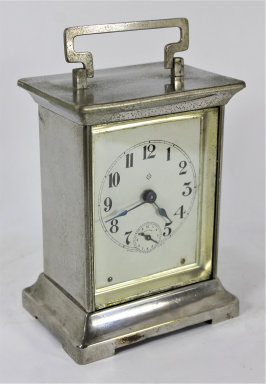
502. $125
E.N. Welch “Carriage No. 2”, ca. 1885. Carriage clocks from Welch are not common; Ly shows
only five in his book on Welch clocks and none are found in the Antique Clocks Price Guide. This model is 7.5 inches tall with
the handle up. The case is brass. It came with a plain white dial or the fancy gilt dial found here. The dial is
paper and is stained and yellowed. The glass is old. It is a one-day lever mechanism with a strike on the hour; it is
running and striking. The bell is under the base. $125-$175.
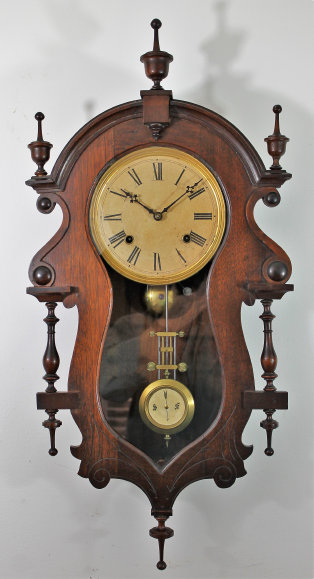
503. $650
Ansonia “Hanging Monogram”, ca. 1874. There are only two listings for this clock in the Antique
Clocks Price Guide and both are from auctions we held in the early 2000’s; both sold for over $1000. One sold on eBay last fall
for something under $1395 (best offer), and a second one sold on eBay this spring for $710. The finials do not match the catalog
illustration shown in Ly’s book on Ansonia clocks, page 169, but all six look very original to me, and they match the turned columns
on both sides of the door. I suspect Ansonia used different finial types in different years. The two listings we sold
in the early 2000’s had different finial types, and one had finials like this one. The 29-inch case looks like walnut. The dial is paper, very old, the hands again not the same as the hands in the catalog drawing. The glass was replaced a while
ago. The fancy pendulum is correct and complete, and the 8-day time and strike unsigned movement is running and keeping time. $650-$1000.
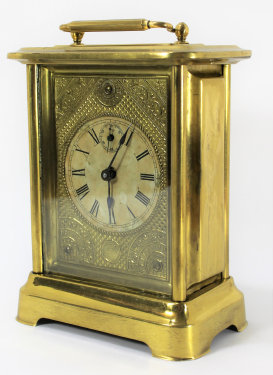
504. $500
Bradley & Hubbard “Continental” blinking eye clock, ca. 1860. A nicely repainted cast iron
novelty, 17 inches high. The 30-hour unsigned lever movement is running. The eyes are original, also repainted, and rock
up and down nicely with the movement. The glass in the bezel is old, the paper dial replaced, and the hands don’t match. This is a very early scalloped base, signed underneath “Bradley & Hubbard, Patent applied for 1857 PCF”. You could do worse. $500-$800.
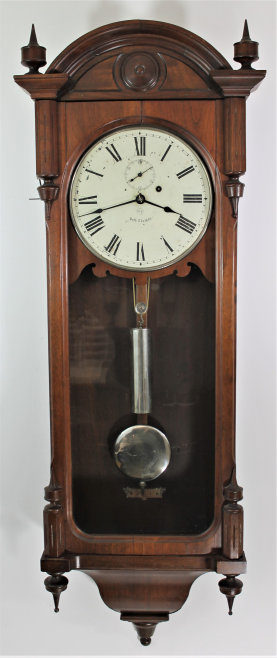
505. $1800
Seth Thomas “Regulator No. 6”, ca. 1880. A walnut case with an old finish and nickel trim
including the damascened pendulum bob, weight, and pulley. The dial holds the original paint with some flaking and wear but
is remarkably good for a Thomas dial. The hands are correct; the beat scale is correct but the finish is worn, and there is
a dent in the bob. All the finials are correct although the bottom center finial looks like a replacement. The door glass
is old and wavy but one retaining strip is newer. The veneer on the shaped base has some problems and has been partially replaced
on both sides. You’ll need to get down on your knees to see the flaws, or look at the provided pictures. The time-only
8-day movement is unsigned and is running and keeping time. There is no label. We sold a very similar example in 2016
for $2500. $1900-$2500.
